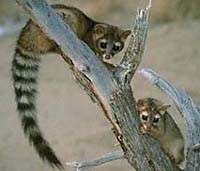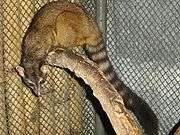Bassariscus
Bassariscus is a genus in the family Procyonidae. There are two species in the genus: the ring-tailed cat or ringtail (B. astutus) and the cacomistle (B. sumichrasti). Genetic studies have indicated that the closest relatives of Bassariscus are raccoons,[1][2][3] from which they diverged about 10 million years ago.[3] The two lineages of Bassariscus are thought to have separated after only another two million years,[1] making it the extant procyonid genus with the earliest diversification.
| Bassariscus | |
|---|---|
 | |
| Scientific classification | |
| Kingdom: | Animalia |
| Phylum: | Chordata |
| Class: | Mammalia |
| Order: | Carnivora |
| Family: | Procyonidae |
| Genus: | Bassariscus Coues, 1887 |
| Species | |
|
Bassariscus astutus | |
The name is a Greek word for fox ("bassaris") with a Latinized diminutive ending ("-iscus").[4] The genus was first described by Elliott Coues in 1887. He proposed the word "bassarisk" as the English term for animals in this genus.[5] Its habitat includes semi-arid areas in the southwestern United States,[6] the whole of Mexico, as well as moist tropical forests in Central America.
Extant Species
| Image | Scientific name | Common Name | Distribution |
|---|---|---|---|
 | Bassariscus astutus | Ring-tailed cat | Southern United States from southern Oregon and California throughout the southwestern states to Texas. In Mexico it ranges from the northern desert state of Baja California to Oaxaca. Its distribution overlaps that of B. sumichrasti in the Mexican states of Guerrero, Oaxaca and Veracruz.[7] |
 | Bassariscus sumichrasti | Cacomistle | Central America, from south central Mexico to Panama |
References
- K.-P. Koepfli; M. E. Gompper; E. Eizirik; C.-C. Ho; L. Linden; J. E. Maldonado; R. K. Wayne (2007). "Phylogeny of the Procyonidae (Mammalia: Carvnivora): Molecules, morphology and the Great American Interchange". Molecular Phylogenetics and Evolution. 43 (3): 1076–1095. CiteSeerX 10.1.1.495.2618. doi:10.1016/j.ympev.2006.10.003. PMID 17174109.
- Eizirik, E.; Murphy, W. J.; Koepfli, K.-P.; Johnson, W. E.; Dragoo, J. W.; Wayne, R. K.; O’Brien, S. J. (2010-02-04). "Pattern and timing of diversification of the mammalian order Carnivora inferred from multiple nuclear gene sequences". Molecular Phylogenetics and Evolution. 56 (1): 49–63. doi:10.1016/j.ympev.2010.01.033. PMC 7034395. PMID 20138220.
- Helgen, K. M.; Pinto, M.; Kays, R.; Helgen, L.; Tsuchiya, M.; Quinn, A.; Wilson, D.; Maldonado, J. (2013-08-15). "Taxonomic revision of the olingos (Bassaricyon), with description of a new species, the Olinguito". ZooKeys (324): 1–83. doi:10.3897/zookeys.324.5827. PMC 3760134. PMID 24003317.
- "Definition of BASSARISCUS". Merriam-Webster. Retrieved 28 June 2018.
- Coues, E. (1887). "Bassariscus, a new generic name in mammalogy". Science. 9 (225): 516. doi:10.1126/science.ns-9.225.516. PMID 17748409.
- "Archived copy". Archived from the original on 2010-08-10. Retrieved 2010-12-01.CS1 maint: archived copy as title (link)
- Timm, R.; Reid, F. & Helgen, K. (2008). "Bassariscus astutus". IUCN Red List of Threatened Species. 2008. Retrieved January 26, 2009.CS1 maint: ref=harv (link)